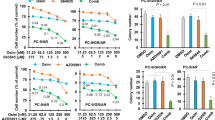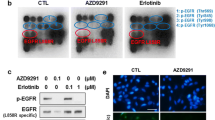Abstract
Non-small cell lung cancer (NSCLC) patients with epithermal growth factor receptor (EGFR) mutations can be treated with EGFR-tyrosine kinase inhibitors (EGFR-TKIs), however, development of acquired resistance could significantly limit curative effects of EGFR-TKIs. Different mechanisms of acquired resistance to first-generation and second-generation EGFR TKIs have been widely reported, but there were few reports on the resistant mechanism of third-generation EGFR-TKI such as osimertinib (AZD9291). In the present study, significant upregulation of Bcl-2 was found in AZD9291-resistant H1975 cells (H1975AR) compared with H1975, which may constitute an important resistant mechanism of acquired resistance to AZD9291. More importantly, our study showed that synergism between AZD9291 and Bcl-2 inhibitor ABT263 (0.25 μM) or ABT199 (1 μM) could effectively overcome the acquired resistance of AZD9291 in H1975AR in vitro. Flow cytometry analyses demonstrated that AZD9291 + ABT263/ABT199 caused a significantly different cell cycle distribution and produced significantly more apoptosis compared with either AZD9291 or ABT263/ABT199 treatment alone. Further multiscreen/Western blot analyses revealed that NF-κB was significantly downregulated in AZD9291 + ABT263/ABT199 treatment groups compared with AZD9291 or ABT263/ABT199 treatment alone, with a more significant reduction of NF-κB in AZD9291 + ABT199 compared with AZD9291 + ABT263. It is also noticeable that AZD9291 + ABT263 specifically caused a significantly reduced expression of p21 compared with AZD9291 or ABT263 treatment alone while AZD9291 + ABT199 specifically caused significantly reduced expressions of SQSTM1 and survivin, but increased expression of autophagosome marker LC3-II compared with AZD9291 or ABT199 treatment alone. Furthermore, cytotoxicity of AZD9291 + ABT199 could be partially reversed by autophagy inhibitor chloroquine. These results suggest that ABT263 and ABT199 may work through different signaling pathways to achieve synergistic cytotoxicity with AZD9291 in H1975AR. These findings suggest that Bcl-2 inhibitor may provide an effective option in combination therapy with EGFR-TKIs to treat NSCLC with EGFR-TKI acquired resistance.





Similar content being viewed by others
References
Bate-Eya LT, den Hartog IJ, van der Ploeg I et al (2016) High efficacy of the BCL-2 inhibitor ABT199 (venetoclax) in BCL-2 high-expressing neuroblastoma cell lines and xenografts and rational for combination with MCL-1 inhibition. Oncotarget 7(19):27946
Bodzak E, Blough MD, Lee PW, Hill R (2008) p53 Binding to the p21 promoter is dependent on the nature of DNA damage. Cell Cycle 7(16):2535–2543
Brown SP, Taygerly JP (2012) Small-molecule antagonists of Bcl-2 family proteins annual reports in medicinal chemistry, vol 47. Elsevier, The amesterdem, pp 253–266
Chen J, Jin S, Abraham V et al (2011) The Bcl-2/Bcl-XL/Bcl-w inhibitor, navitoclax, enhances the activity of chemotherapeutic agents in vitro and in vivo. Mol Cancer Ther 10(12):2340–2349
Cheong HT, Xu F, Choy CT et al (2018) Upregulation of Bcl2 in NSCLC with acquired resistance to EGFR-TKI. Oncol Lett 15(1):901–907
Crombie J, Davids MS (2017) Venetoclax for the treatment of patients with chronic lymphocytic leukemia. Future Oncol 13(14):1223–1232
Froehlich TC, Müller-Decker K, Braun JD et al (2019) Combined inhibition of Bcl-2 and NFκB synergistically induces cell death in cutaneous T-cell lymphoma. Blood 134(5):445–455
Galvani E, Sun J, Leon LG et al (2015) NF-κB drives acquired resistance to a novel mutant-selective EGFR inhibitor. Oncotarget 6(40):42717
Garg H, Suri P, Gupta JC, Talwar G, Dubey S (2016) Survivin: a unique target for tumor therapy. Cancer Cell Int 16(1):49
Jaiswal PK, Goel A, Mittal R (2015) Survivin: a molecular biomarker in cancer. Indian J Med Res 141(4):389
Kögel D, Prehn JH (2013) Caspase-independent cell death mechanisms Madame Curie Bioscience Database [Internet]. Landes Bioscience
Li J, Chen Y, Wan J et al (2014) ABT-263 enhances sorafenib-induced apoptosis associated with A kt activity and the expression of B ax and p21 (CIP1/WAF1) in human cancer cells. Br J Pharmacol 171(13):3182–3195
Lin Q-h, Que F-c, Gu C-p et al (2017) ABT-263 induces G 1/G 0-phase arrest, apoptosis and autophagy in human esophageal cancer cells in vitro. Acta Pharmacol Sin 38(12):1632–1641
Liu X, Chen X, Shi L et al (2019) The third-generation EGFR inhibitor AZD9291 overcomes primary resistance by continuously blocking ERK signaling in glioblastoma. J Exp Clin Cancer Res 38(1):219
Liu Z, Gao W (2017) Leptomycin B reduces primary and acquired resistance of gefitinib in lung cancer cells. Toxicol Appl Pharmacol 335:16–27
Liu Z, Gao W (2019) Overcoming acquired resistance of gefitinib in lung cancer cells without T790M by AZD9291 or Twist1 knockdown in vitro and in vivo. Arch Toxicol 93:1555–1571
Lv T, Wang Q, Cromie M et al (2015) Twist1-mediated 4E-BP1 regulation through mTOR in non-small cell lung cancer. Oncotarget 6(32):33006
Oltersdorf T, Elmore SW, Shoemaker AR et al (2005) An inhibitor of Bcl-2 family proteins induces regression of solid tumours. Nature 435(7042):677
Patel H, Pawara R, Ansari A, Surana S (2017) Recent updates on third generation EGFR inhibitors and emergence of fourth generation EGFR inhibitors to combat C797S resistance. Eur J Med Chem 142:32–47
Qi R, Liu XY (2006) New advance in caspase-independent programmed cell death and its potential in cancer therapy. Int J Biomed Sci 2(3):211
Santarpia M, Liguori A, Karachaliou N et al (2017) Osimertinib in the treatment of non-small-cell lung cancer: design, development and place in therapy. Lung Cancer (Auckl) 8:109
Siddiqui WA, Ahad A, Ahsan H (2015) The mystery of BCL2 family: Bcl-2 proteins and apoptosis: an update. Arch Toxicol 89(3):289–317
Su J, Liu F, Xia M et al (2015) p62 participates in the inhibition of NF-κB signaling and apoptosis induced by sulfasalazine in human glioma U251 cells. Oncol Rep 34(1):235–243
Suvarna V, Singh V, Murahari M (2019) Current overview on the clinical update of Bcl-2 anti-apoptotic inhibitors for cancer therapy. Eur J Pharmacol 862:172655
Tang Z-H, Cao W-X, Su M-X, Chen X, Lu J-J (2017) Osimertinib induces autophagy and apoptosis via reactive oxygen species generation in non-small cell lung cancer cells. Toxicol Appl Pharmacol 321:18–26
Tsapras P, Nezis IP (2017) Caspase involvement in autophagy. Cell Death Differ 24(8):1369–1379
Wang C, Huang S-B, Yang M-C et al (2015) Combining paclitaxel with ABT-263 has a synergistic effect on paclitaxel resistant prostate cancer cells. PLoS ONE 10(3):e0120913
Wu H, Che X, Zheng Q et al (2014) Caspases: a molecular switch node in the crosstalk between autophagy and apoptosis. Int J Biol Sci 10(9):1072
Wu S-G, Shih J-Y (2018) Management of acquired resistance to EGFR TKI–targeted therapy in advanced non-small cell lung cancer. Mol Cancer 17(1):38
Xu M, Xie Y, Ni S, Liu H (2015) The latest therapeutic strategies after resistance to first generation epidermal growth factor receptor tyrosine kinase inhibitors (EGFR TKIs) in patients with non-small cell lung cancer (NSCLC). Ann Transl Med 3(7):96
Xu W, Tang W, Li T, Zhang X, Sun Y (2019) Overcoming resistance to AC0010, a third generation of EGFR Inhibitor, by targeting c-MET and BCL-2. Neoplasia 21(1):41–51
Yang L, Ying S, Hu S et al (2019) EGFR TKIs impair lysosome-dependent degradation of SQSTM1 to compromise the effectiveness in lung cancer. Signal Transduct Target Ther 4(1):1–11
Yoneda K, Imanishi N, Ichiki Y, Tanaka F (2019) Treatment of non-small cell lung cancer with EGFR-mutations. J UOEH 41(2):153–163
Zhan Y, Wang Y, Qi M et al (2019) BH3 mimetic ABT-263 enhances the anticancer effects of apigenin in tumor cells with activating EGFR mutation. Cell Biosci 9(1):60
Zhang J, Wang S, Wang L et al (2015) Prognostic value of Bcl-2 expression in patients with non-small-cell lung cancer: a meta-analysis and systemic review. Onco Targets Ther 8:3361
Zhang Z, Zhang M, Liu H, Yin W (2019) AZD9291 promotes autophagy and inhibits PI3K/Akt pathway in NSCLC cancer cells. J Cell Biochem 120(1):756–767
Zhou Q, Wu L, Feng L et al (2019) Safety and efficacy of abivertinib (AC0010), a third-generation EGFR tyrosine kinase inhibitor, in Chinese patients with EGFR-T790M positive non-small cell lung cancer (NCSLC). J Clin Oncol 43:180–187
Zou M, Xia S, Zhuang L et al (2013) Knockdown of the Bcl-2 gene increases sensitivity to EGFR tyrosine kinase inhibitors in the H1975 lung casncer cell line harboring T790M mutation. Int J Oncol 42(6):2094–2102
Acknowledgement
This research was partially supported by the National Institute of Environmental Health Sciences of the National Institutes of Health under Award Number R15ES026789. The content is solely the responsibility of the authors and does not necessarily represent the official views of the National Institutes of Health.
Author information
Authors and Affiliations
Corresponding author
Ethics declarations
Conflict of interest
The authors that there is no conflict of interest.
Additional information
Publisher's Note
Springer Nature remains neutral with regard to jurisdictional claims in published maps and institutional affiliations.
Rights and permissions
About this article
Cite this article
Liu, Z., Gao, W. Synergistic effects of Bcl-2 inhibitors with AZD9291 on overcoming the acquired resistance of AZD9291 in H1975 cells. Arch Toxicol 94, 3125–3136 (2020). https://doi.org/10.1007/s00204-020-02816-0
Received:
Accepted:
Published:
Issue Date:
DOI: https://doi.org/10.1007/s00204-020-02816-0




